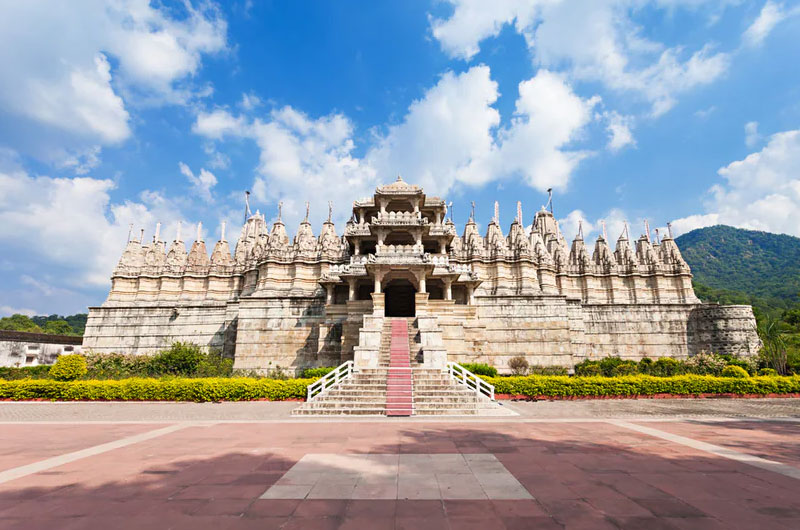
Ranakpur Jain Temple: A Majestic Tribute to Jain Architecture and Spirituality
Nestled in the serene Aravalli hills of Rajasthan, the Ranakpur Jain Temple is a masterpiece of architectural brilliance and spiritual significance. Dedicated to Tirthankara Adinatha, the temple is renowned for its intricate marble carvings, majestic pillars, and tranquil ambiance. As one of the largest and most important Jain temples in India, Ranakpur stands as a symbol of Jain artistic and religious heritage. This detailed guide explores the temple’s architectural splendor, historical background, tourism highlights, and practical travel information to enhance your visit.
Historical Significance
Origins and Construction
- Foundation and Patronage: The Ranakpur Jain Temple was commissioned in the 15th century by Rana Kumbha, the then ruler of Mewar, and was constructed between 1437 and 1458 CE. It was built under the guidance of the Jain merchant Seth Dharma Shah, who played a significant role in its development.
- Architectural Mastery: The temple’s design is attributed to the architect Sompura, renowned for his skill in crafting intricate stone carvings. The temple is an exemplary representation of the Solanki architectural style, characterized by its ornate marble work and elaborate detailing.
Historical Context
- Jainism in Rajasthan: The Ranakpur Temple is a testament to the influence of Jainism in Rajasthan. Jainism, with its emphasis on non-violence, truth, and asceticism, has had a profound impact on the region’s cultural and religious landscape.
- Cultural Resilience: Despite facing challenges over the centuries, including political upheavals and natural calamities, the temple has preserved its grandeur and continues to attract devotees and tourists from across the globe.
Architectural Marvel
Temple Structure
- Main Shrine (Garbhagriha): The main shrine of the Ranakpur Jain Temple houses a magnificent idol of Tirthankara Adinatha, meticulously carved from white marble. The Garbhagriha is adorned with elaborate frescoes and sculptures, depicting various Jain deities and mythological figures.
- Pillared Halls (Mandapas): The temple features 29 halls supported by 1,444 exquisitely carved pillars. Each pillar is unique, showcasing different motifs and designs, including floral patterns, celestial beings, and divine figures.
Notable Features
- Shikhara (Spire): The temple’s Shikhara rises above the sanctum, symbolizing Mount Meru, the axis of the universe in Jain cosmology. It is adorned with intricate carvings and adds to the temple’s overall grandeur.
- Chaumukha (Four-Faced Temple): The Ranakpur Temple is also known as the Chaumukha Temple due to its four-faced design. The four faces represent the four cardinal directions and are integral to the temple’s spiritual symbolism.
Art and Carvings
- Marble Carvings: The temple’s marble carvings are a highlight of its architecture. The detailed artwork includes elaborate floral designs, mythological scenes, and depictions of Jain Tirthankaras. The craftsmanship exemplifies the skill and artistry of the artisans of the time.
- Ceiling Artwork: The ceilings of the temple are adorned with intricate patterns and designs, including celestial figures and symbolic motifs. The ceiling artwork enhances the temple’s aesthetic appeal and adds to its spiritual ambiance.
Tourism Specialty and Locality
Unique Attractions
- Religious Significance: The Ranakpur Jain Temple is a major pilgrimage site for Jains and is considered one of the five major Jain temples in India. It is renowned for its spiritual significance and is a place of worship, meditation, and reflection.
- Architectural Excellence: The temple’s architectural splendor, with its intricate marble carvings and unique design elements, makes it a significant example of Jain temple architecture. It attracts visitors interested in art, history, and architecture.
Locality
- Location: The Ranakpur Jain Temple is situated in Ranakpur village, located in the Pali district of Rajasthan. It is approximately 91 kilometers from Udaipur and about 340 kilometers from Jodhpur.
- Accessibility: The temple is accessible by road, with well-maintained routes connecting it to major cities in Rajasthan. The nearest railway station is in Falna, about 35 kilometers away, and the nearest airport is in Udaipur, approximately 91 kilometers from the temple.
Best Time to Visit
Ideal Seasons
- Winter Season (October to March): The best time to visit the Ranakpur Jain Temple is during the winter months when the weather is pleasant and suitable for sightseeing. Daytime temperatures range from 10°C to 30°C (50°F to 86°F), making it comfortable for exploration.
- Monsoon Season (June to September): The monsoon season brings moderate to heavy rainfall, which can enhance the scenic beauty of the temple surroundings. However, it may also lead to travel disruptions and muddy conditions.
Summer Season (April to June)
- Weather Conditions: The summer months can be extremely hot, with temperatures exceeding 40°C (104°F). While the temple remains open, the heat may make travel and outdoor activities less enjoyable.
Nearby Tourist Spots
In Rajasthan
- Udaipur: Located about 91 kilometers from Ranakpur, Udaipur is known for its stunning lakes, palaces, and temples. Major attractions include the City Palace, Lake Pichola, and Jag Mandir.
- Kumbhalgarh Fort: Approximately 85 kilometers from Ranakpur, Kumbhalgarh Fort is a UNESCO World Heritage Site renowned for its massive walls and historical significance. It offers panoramic views of the Aravalli hills.
- Mount Abu: Around 165 kilometers from Ranakpur, Mount Abu is a popular hill station in Rajasthan. It is known for its cool climate, scenic landscapes, and attractions like the Dilwara Temples and Nakki Lake.
Nearby Attractions
- Jaisalmer: Known as the “Golden City,” Jaisalmer is about 300 kilometers from Ranakpur and is famous for its golden sandstone architecture, including the Jaisalmer Fort and Havelis.
- Ranakpur Village: The village surrounding the temple offers a glimpse into rural Rajasthan life. Visitors can explore local crafts, traditional cuisine, and the scenic landscape.
Best Places to Eat
Local Dining Options
- The King’s Abode Restaurant: Located near the Ranakpur Temple, The King’s Abode Restaurant offers a range of vegetarian dishes, including local Rajasthani cuisine. It provides a comfortable dining experience with a view of the temple surroundings.
- Siddhi Vinayak Restaurant: Situated in Ranakpur village, Siddhi Vinayak Restaurant serves traditional Indian and Rajasthani meals. It is a popular choice for visitors looking for authentic local flavors.
Nearby Restaurants
- Udaipur:
- Ambrai Restaurant: Located by Lake Pichola in Udaipur, Ambrai Restaurant offers a fine dining experience with a beautiful lake view. It serves a variety of Indian and continental dishes.
- Khamma Ghani Restaurant: Known for its traditional Rajasthani cuisine, Khamma Ghani Restaurant provides an authentic dining experience with local specialties.
- Jodhpur:
- Ravla Restaurant: Located in Jodhpur, Ravla Restaurant offers a blend of traditional Rajasthani and Indian dishes in a charming setting. It is a great place to experience local flavors.
- On The Rocks: Known for its relaxed ambiance and diverse menu, On The Rocks provides a mix of Indian, continental, and Chinese cuisine.
Hotels Near Ranakpur Jain Temple
Luxury Hotels
- The King’s Abode: Located near the temple, The King’s Abode offers luxurious accommodations with modern amenities and stunning views of the Aravalli hills. It is an ideal choice for travelers seeking a high-end experience.
- Mana Hotels: Situated in Ranakpur, Mana Hotels provides upscale accommodations with well-appointed rooms, an on-site restaurant, and excellent service. It offers a comfortable and elegant stay for visitors.
Budget Hotels
- Hotel Shree Kundan: Located in Ranakpur, Hotel Shree Kundan offers budget-friendly accommodations with essential facilities. It is a convenient choice for travelers looking for economical lodging.
- Hotel Ranakpur Hill: A budget hotel in Ranakpur, Hotel Ranakpur Hill provides basic amenities and a comfortable stay. It is a practical option for visitors seeking affordable accommodations near the temple.
Pilgrimage and Visitor Experience
Preparing for the Visit
- Travel Preparation: Visitors should plan their trip in advance, considering travel logistics, accommodation, and local transportation. It is advisable to dress modestly and respect the temple’s customs and traditions.
- Entry and Tickets: There is no entry fee to visit the Ranakpur Jain Temple. However, donations and offerings are welcomed. Visitors should be aware of the temple’s schedule and adhere to any specific guidelines or regulations.
Exploring the Site
- Guided Tours: Guided tours are available and can provide valuable insights into the temple’s history, architecture, and religious significance. Tours can be arranged through local tour operators or the temple administration.
- Souvenirs and Shopping: The area around the temple features small shops selling religious artifacts, souvenirs, and local products. Visitors can purchase mementos to remember their visit and support local artisans.
Conclusion
The Ranakpur Jain Temple, with its exquisite architecture, rich history, and spiritual significance, stands as a remarkable testament to Jain heritage and artistry. Its intricate carvings, serene surroundings, and historical context make it a must-visit destination for history enthusiasts, architecture lovers, and spiritual seekers. By exploring the temple’s grandeur and learning about its background, visitors can gain a deeper appreciation for Rajasthan’s cultural and religious tapestry.
